
What are the Different Types of Orthodontic Retainers?
So you’ve finally finished your orthodontic treatment with dental braces or Invisalign. It’s time to flaunt that new smile you’ve been waiting so patiently to see. Yet as exciting as it is to get your braces off or eliminate your last Invisalign aligner, therapy does not fairly stop there. After any kind of therapy, it is very important to put on an orthodontic retainer to see to it your beautiful, brand-new smile lasts a lifetime. There are numerous types of retainers to select from.
What is an orthodontic retainer anyway, and why do you need to put on one? Do you need to use it forever? Dr. Elliot has the answers to every one of these questions—therefore, a lot more! Here, in Phoenix, AZ, Saperstein Orthodontics shares everything you need to understand about all the various types of orthodontic retainers. Let’s dive in.
What Does an Orthodontic Retainer Do?
For the duration of your braces or Invisalign treatment, your orthodontic tool gradually overviews your teeth right into their perfect position. Since you’ve finished with the treatment phase, you have finished with the maintenance phase of your smile’s trip. An orthodontic retainer is the key to preserving your perfect smile.
Your teeth and jaw have been through a whole lot considering that you began therapy. It’s just all natural that they’ll intend to loosen up a little bit once they’re devoid of equipment. They may even shift back right into their original placement with time, and no one desires that! This is where your orthodontic retainer is available: as the name suggests, it will preserve your teeth’s optimal positioning. Orthodontic retainers prevent your teeth from moving back to square one and maintain them specifically where you want them to be.
And indeed, you are required to wear your retainer forever. For the first few months, you’ll need to wear it full-time. After that, your teeth will be secured right into location, yet you’ll still be required to wear your retainer at night. This will certainly make certain your teeth don’t relapse, which occurs when they move back to their natural location.
Which Sort of Orthodontic Retainer is Right for Me?
Just like there’s a range of orthodontic treatment alternatives, there are also several sorts of orthodontic retainers to pick from. Some are detachable and others are taken care of; some are made from clear plastic and others are made from a steel cable. The type of retainer you select for your post-braces or Invisalign care will depend on your unique circumstances. To aid you in making a decision about which one is ideal for you, right here’s a breakdown of the various kinds of orthodontic retainers:
Hawley Retainers
Additionally called cord retainers, Hawley retainers are detachable tools made from a thin metal cord and either plastic or acrylic. The plastic/acrylic part is personalized to fit the roof of your mouth, while the cable leaves beyond your teeth to keep them straightened. While more resilient than other sorts of retainers, they’re likewise a lot more obvious.
Pros:
When cared for properly, Hawley retainers are incredibly long-lasting and can last for years.
If you break your Hawley retainer, it may be repairable.
It can be adjusted to improve the fit.
Your upper and reduced teeth can touch normally with a Hawley retainer.
You can choose enjoyable customized shades.
Disadvantages:
Hawley retainers can influence your speech more than other types of retainers.
They’re more obvious than various other types of retainers.
The cord can irritate your lips or cheeks in the beginning.
Vivera Retainers
Vivera retainers are the official Invisalign retainers. They’re tailor-made using the very same state-of-the-art modern technology as Invisalign and are made particularly to enhance your Invisalign therapy. Molded to perfectly fit the brand-new placement of your teeth, Vivera retainers help you maintain your new smile. While the majority of Invisalign patients will just require a Vivera Invisalign retainer, permanent retainers might be required in certain cases.
Pros:
Vivera retainers are invisible.
They’re backed by the tested Invisalign system.
They’re more long-lasting than other clear retainers.
They’re less likely to affect your speech than a Hawley retainer.
Since they’re detachable, you can conveniently brush and floss to keep your teeth healthy.
Cons:
Because they cannot be changed, you would certainly need a new retainer if you require adjustment.
The plastic may warp if exposed to warmth (including hot water).
They may end up being tarnished with time.
They can’t be repaired if broken.
Your top and bottom teeth cannot touch normally with a Vivera retainer.
Essix Retainers
Another kind of clear plastic retainer, Essix retainers, is similar to Vivera retainers. They hold your teeth in the proper setting and can also supply small adjustments to misaligned teeth. Six retainers are made from thinner plastic than Vivera retainers, which indicates they may not last as long as other kinds of retainers.
Pros:
Essix retainers are virtually undetectable.
They’re much less likely to influence your speech than a Hawley retainer.
Given that they’re detachable, you can conveniently clean and floss to maintain your teeth healthy and balanced.
Disadvantages:
Given that they cannot be adjusted, you’d require an entirely brand-new retainer if you require adjustment.
The plastic might warp if exposed to warmth (consisting of hot water).
They might become blemished with time.
They cannot be repaired if broken.
Your leading and lower teeth cannot touch normally with an Essix retainer.
Long-term Retainers
Since we have covered all types of detached retainers, let’s talk about long-term retainers. They include a straightforward wire adhered to the inside of your front teeth (usually the lower teeth) to keep them fixed in position. Permanent retainers are most frequently used for people at high risk of regression or who are likely not to comply with instructions for putting on a detachable retainer. Permanent retainers can just be gotten rid of by a dental practitioner or orthodontist.
Pros:
You do not need to bother with exactly how commonly to wear your retainer since it’s repaired in place.
It’s invisible to others.
It will not influence your speech.
It cannot be lost or shed.
It’s not likely to break.
Cons:
Considering that you can’t remove an irreversible retainer, it can be challenging to clean and floss correctly. This can lead to plaque and germ accumulation.
It can take some time to get used to the feeling of a long-term retainer.
The steel wire might aggravate your tongue.
Still, you have inquiries concerning why you must use an orthodontic retainer or which kind of retainer is right for you. Call Saperstein Orthodontics today for a conversation.

